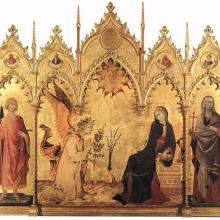virgin birth
The gospel writers were not fixated on Mary’s sexual history; it’s the institutional church that objectified her — casting her as a perpetual virgin, elevating her sexual experience (or lack thereof) to be the most important thing about her
Sculpture of Mary and Elizabeth and Church of the Visitation in Jerusalem. Creative Commons license.
In America, baby showers are times for women to come together and celebrate new life; presents are exchanged, advice given, and games played. Mary and Elizabeth celebrated the new life within them by exchanging presents of joy, encouragement, song, and prophecy. Both women were carrying children of promise. Neither woman had a convenient pregnancy. Mary and Elizabeth’s celebration shows the importance of women coming together for prayer, praise, and prophecy.
In her first televised interview in more than a decade, Monica Lewinsky (who needs no introduction) says she was “a virgin to humiliation” at the time she made highly explicit world news about her White House trysts with then-President Bill Clinton.
Lewinsky may have coined a new term here in this National Geographic documentary on the 1990s. (And if she’s trying to change the subject for which she is so unfortunately known, this was not a good choice of words.)
The word virgin, in addition to its usual meaning, uses sexual inexperience as a metaphor for a state of being unviolated, untainted, innocent, clean. That association is damaging. It suggests that sex is bad, that it’s always a violation. I think most can agree that this is not true.
The concept of virgin birth — which occurs in more than one religion — does not argue for sex being a bad idea, though it can easily be taken that way; such an event can instead simply show that the child’s father is divine. In addition, Catholic doctrine of Immaculate Conception does not mean that the birth came about by a “cleaner” method than the usual biological one; this is instead a belief in Mary as a person born without sin.
In the sixth month of Elizabeth’s pregnancy, God sent the angel Gabriel to Nazareth, a town in Galilee, to a virgin pledged to be married to a man named Joseph, a descendant of David. The virgin’s name was Mary.
The beautiful anonymity and soft innocence of a young girl in Nazareth would be stripped by an angelic visitation. Who could ever envision the global veneration soon to commence? This Holy Virgin of Martini's masterpiece cannot be Mary's vision. The gilded, enthroned Mother of God, Blessed Virgin, Theotokos, Panagia. Millenia of adoration blurs the humanity of such a terrifying moment in the life of a child.
The angel went to her and said, “Greetings, you who are highly favored! The Lord is with you.”
Gabriel's praise for her resounds the Earth this Advent Season. Martini paints the words spouting from Gabriel's mouth, invading Mary's space. Her shoulder shrug speaks to Luke's revelations of her humanity. The Gospel record exposes her vulnerability and reluctance to embrace such a startling event.


